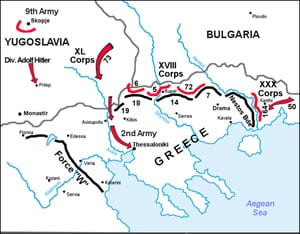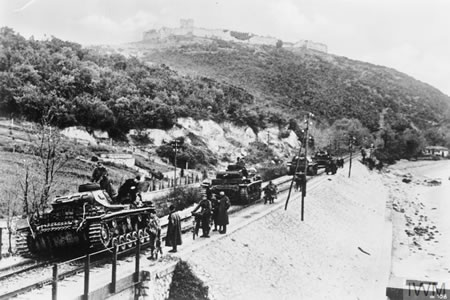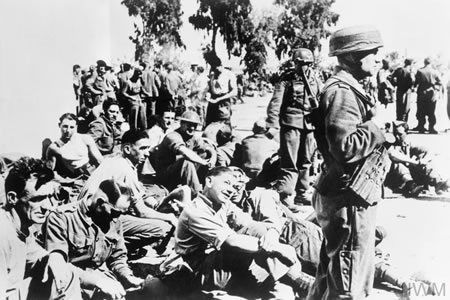Middle East (Greece and Crete) 1941

Germany invaded Yugoslavia and Greece on 6 April 1941. Outnumbered on the ground and in the air the Greek and Allied forces were unable to deploy sufficient troops in any one area to halt the German advance.
The campaign was also hindered by poor communications between the Greek and Allied commanders, the difficult terrain and the under-developed road and rail system.
The 4th Hussars arrived in Greece on 10-11 March 1941 having sailed from Alexandria on the 9th.

Germany invades Greece – 6 Apr 1941
Outnumbered on the ground and in the air the Greek and Allied forces were unable to deploy sufficient troops in any one area to halt the German advance.
The campaign was also hindered by poor communications between the Greek and Allied commanders, the difficult terrain and the under-developed road and rail system.
The 4th Hussars were near Salonika when they were attacked by fifteen German divisions on 6 April, and the retreat began the next day.

Salonika Occupied – 8 Apr 1941
Greek and Allied troops began to fall back as the Germans moved rapidly through the country, occupying Salonika on 8 April.
By 20 April, it was clear that the Allied forces could do no more than disrupt and slow the German advance. The Greek government agreed that the force should be evacuated.
On 23 April the Greek army itself surrendered. King George II of Greece and his government escaped to Crete.
The 4th Hussars executed a magnificent holding action at Proasteion on 13 April that allowed the infantry to withdraw, the Germans under the impression that they were faced by a whole armoured division.
The 4th Hussars were often the rearguard as the retreat continued all the way down Greece and onto the Peloponnese where they were detailed to defend the whole north shore against landings while the allied troops were evacuated further south.
4th Hussars action at Proateion
4th Hussars held the
Corinth Canal Bridge
Discover the story of LCpl Patrick Fury, 4th Hussars, who was captured in Greece

Evacuation from Greece – 24 Apr 1941
The evacuation of Allied forces from Greece began on 24 April and continued for a week. Despite a severe shortage of Allied shipping, more than 50,000 British, Australian, New Zealand and Polish troops were evacuated.
On the 26th the Corinth Canal Bridge, held by three tanks and four platoons of men from RHQ, 4th Hussars, was attacked by over 1,000 glider and paratroops who eventually overran the British but not before the bridge was blown up successfully.
All their tanks, heavy equipment and trucks were abandoned. Most of the troops were taken to Crete, but others went to Egypt.
A number of small, isolated groups and individuals were cut off from the retreat and left behind in Greece. Many escaped with the assistance of the local population.
Others became prisoners of war. 3,700 Allied and more than 15,000 Greek soldiers were killed in the battle for Greece.

Athens Occupied – 27 Apr 1941
On 27 April, German troops occupied the Greek capital, Athens. Following the Greek surrender Germany, Italy and Bulgaria divided the country into 3 zones of occupation. German and Italy jointly occupied Athens.
The German Blitzkrieg tactics had overwhelmed British forces sent in to assist the Greek troops.
Thousands of British soldiers were captured and many more evacuated.

Crete Campaign – 1941
The Battle for Crete was one of the most dramatic battles of the Second World War.
Over 12 days in May 1941 a mixed force of New Zealanders, British, Australian and Greek troops desperately tried to fight off a huge German airborne assault.
Despite suffering appalling casualties, the parachutists and glider-borne troops who led the invasion managed to secure a foothold on the island and eventually gained the upper hand.
The battle ended with the evacuation to Egypt of the bulk of the Allied force.

Arrival in Crete – 16 May 1941
On May 11 ‘C’ Squadron, 3rd Hussars were suddenly ordered to deploy to Crete: they collected sixteen light tanks and thirty trucks and sailed in convoy to SUDA BAY, arriving on the 16th.
On the 18th, six tanks were ordered to to the Heraklion sector and on the 19th the remaining ten moved to Canea, in the north-west corner of the island.

German paratroopers land on Crete – 20 May 1941
n the morning of 20 May, around 3,000 German paratroopers fell out of the sky in the Canea-Suda area and at Maleme, Réthimnon and Iráklion.
By the end of the day, this number had doubled and was being further reinforced by parachutists, gliders and eventually troop carriers. These began landing on Maleme airfield while it was still under Allied fire.
Eventually, some 22,000 of Germany’s toughest troops arrived in Crete. The Allies were numerically superior but less highly trained; many had only recently been evacuated from Greece.
They were also badly equipped, but nonetheless many put up stiff resistance. After the war, General Student recalled that ‘the infantry, mostly New Zealanders, put up a stiff fight, though taken by surprise’.
Despite fierce fighting, by 26 May Freyberg reported that ‘the limit of endurance has been reached by the troops under my command’ our position here is hopeless’.

Evacuation of Crete – 28 May 1941
‘C’ Squadron 3rd Hussars managed to hold out until the evening of the 28th, when they were ordered to destroy their tanks.
Evacuation began on the night of 28 May. It lasted three days, with the Royal Navy suffering heavy losses from German air attacks.
They managed to rescue around 16,500 troops, but the rest were either killed or captured.
The Navy itself lost around 2,000 men as three cruisers and six destroyers were sunk.
On 31 May the last remaining defenders were overwhelmed at Réthimnon.

